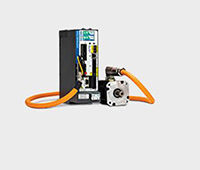Food processors in the U.S. face an unprecedented competitive environment and must look for ways to be profitable without negatively affecting the quality of finished products. The challenge of maintaining high product quality while simultaneously reducing production costs can often be met through investments in energy efficiency, which may include the purchase of energy-efficient technologies like high-efficiency motor systems.
According to the Department of Energy (DOE), electric motor-driven systems are estimated to consume more than half of all electricity in the U.S. and more than 70% of all electricity in food and beverage manufacturing applications. These processing plants are large users of energy for refrigeration, cooking, heating, boilers and steam generation, sterilizing, conveyors and auxiliary equipment. However, because energy is typically viewed as peripheral to the business of production, efficiency projects have an uphill fight for capital and attention. Even if organizations adopt a more holistic approach to energy, managers and engineers often don’t have the time to analyze payback from various projects and prioritize them. But this should be one of the first places to look for reducing costs and improving productivity and profits.
 The typical industrial plant in the U.S. can reduce its electricity use by around 5 to 15% by improving the efficiency of its motor-driven systems. Process manufacturing has the highest absolute consumption of electricity, 419,587 GWh/year, and motor systems account for 71% of this total.
The typical industrial plant in the U.S. can reduce its electricity use by around 5 to 15% by improving the efficiency of its motor-driven systems. Process manufacturing has the highest absolute consumption of electricity, 419,587 GWh/year, and motor systems account for 71% of this total.
A significant challenge in promoting high-efficiency motors is that motor buyers often misunderstand where the costs of motor ownership lie, and therefore do not account for these costs accurately. The greatest cost of motor ownership is that of operating the motor, which represents 97 to 98% of lifetime costs. Initial purchase price represents only an estimated 2 to 3%.
Electric motors used in production facilities with conveyors are almost always on, driving the energy bill higher. But what if there was a way to reduce energy consumption and costs while increasing the efficiency level? There is—through the use of high-efficient motors. Energy efficient motors make economic sense: In an industrial application operating 4,000 hours/year, energy-efficient motors earn back their initial cost in two years.
Many state organizations and energy companies have created monetary rebate programs available to qualifying businesses. For example, the Wisconsin Food Processing Plant and Food Warehouse Investment Credit is a refundable tax credit for businesses that have invested to modernize or expand food processing plants or food warehouses in Wisconsin and who have been certified by the Wisconsin Department of Commerce.
Tax credits are earned by incurring eligible expenses for modernization or expansion of a food processing plant or food warehouse. This includes constructing, improving or acquiring buildings or facilities, or acquiring equipment for food processing or food warehousing.
Wisconsin also has the Meat Processing Facility Investment Credit program to support the modernization of the state’s meat processing industry. The tax credits build on the success of the state’s dairy modernization and investment tax programs. The program provides a tax credit for up to 10% of the expenditures meat processors invest in modernization or expansion. Eligible costs include construction, additions, utility upgrades, equipment, technology and other upgrades.
 In southern Indiana, Dubois REC and other local rural electric cooperatives, in a partnership with Hoosier Energy, have created a monetary rebate program for energy efficient upgrades. Local electric cooperatives have been offering rebates on energy efficiency upgrades through Hoosier Energy since 2009.
In southern Indiana, Dubois REC and other local rural electric cooperatives, in a partnership with Hoosier Energy, have created a monetary rebate program for energy efficient upgrades. Local electric cooperatives have been offering rebates on energy efficiency upgrades through Hoosier Energy since 2009.
Submitted by Cheryl Higgins, product marketing manager, LEESON Electric, www.leeson.com.
Filed Under: Green engineering • renewable energy • sustainability, Energy management + harvesting, MOTION CONTROL





Tell Us What You Think!